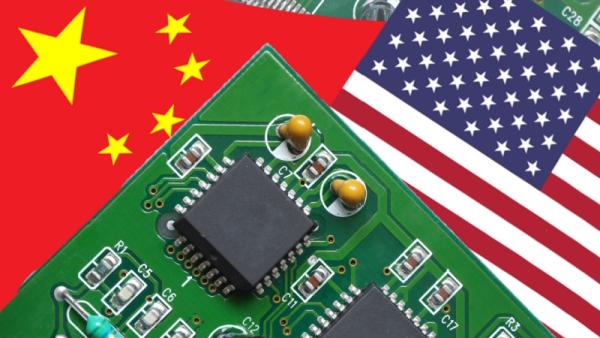Australia’s coming battles in the US–China tech war
Hsyn20 / Shutterstock

Marina Yue Zhang, Associate Professor – Research, Australia-China Relations Institute, University of Technology Sydney |
| Mark Dodgson, Emeritus Professor, University of Queensland; Innovator in Residence, University of Oxford |
| David Gann, Professor of Innovation and Entrepreneurship, Said Business School, University of Oxford; Chairman, UK Industrial Fusion Solutions. |
Note: This article appeared in the East Asia Forum on April 25 2024.
The technological race between the United States and China is a defining narrative of our times. The contest, far more than a mere rivalry over technological supremacy, encapsulates the shifting of economic power, national security imperatives and soft power that will shape the new world order.
Humanity has witnessed three industrial revolutions, each of which has positioned its epicentre as the economic hub of its era. As the third revolution draws to a close, the seeds of a new wave are being sown. The nation that emerges as the centre of this forthcoming technological revolution will become the economic nucleus of the coming new age. The rapid rise of China’s scientific and technological power is seen as a threat to the United States’ supremacy in the new technological revolution.
Against this backdrop, there have been escalating levels of techno-nationalism, characterised by nations prioritising the development and protection of domestic technological capacities over purely economic considerations. This focus extends to an arms race in industrial policies and technology sovereignty.
The rise of China as a technological powerhouse and its assertive recalibration of its international standing have raised concerns about China’s potential threat to the existing world order. From Washington’s perspective, China’s technological advancements not only strengthen a strategic competitor, but also potentially enhance its military capabilities, threatening US national security.
Accordingly, the United States has implemented technology sanctions and export controls in select areas such as advanced semiconductors, and has introduced policies to protect its domestic manufacturing capability. These policies are viewed as protective measures against China’s technological ascendance. But China sees these actions as attempts to impede its development and has initiated retaliatory measures such as export controls on critical metals and rare earth separation technologies.
The disparity in perspectives on the US–China tech rivalry has transformed their previously symbiotic relationship into a tug-of-war within a techno-nationalist race. This risks not only segregating supply chains, but also decoupling technology. The danger lies in the United States’ reluctance to be surpassed by China, just as China is unlikely to relinquish its aspirations for growth. The stakes of the US–China tech rivalry are incredibly high, with the potential to reshape the broader geopolitical landscape.
To mitigate the drawbacks of techno-nationalism and prevent technological decoupling, more refined policies are necessary. It is essential to fight the right technology battles, as different technologies have varying applications and geopolitical implications.
Navigating the technological battleground necessitates strategies tailored to different technological domains. It is crucial to safeguard technologies that could enhance the strategic or military advantages of an adversary. It is equally important to seek areas of complementarity and cooperation, especially in tackling global challenges. The strategic decisions made by each country today will not only shape the trajectory of US–China relations but will also profoundly influence the international community’s approach to technology, security and diplomacy for decades to come.
General-purpose technologies, such as semiconductors and artificial intelligence, necessitate more defensive policies due to their potential military and security impacts as well as their sometimes unpredictable consequences. Yet in areas critical to sustainable development — including renewable energy, public health and basic scientific research — global collaboration should take precedence over competition.
Policymaking should be based on comprehensive evaluations of the nature of technological development and the sustainable competitive advantages that can be derived from innovative technologies. Identifying current and future competitive advantages should draw upon well-established technology assessment toolkits.
Technological decoupling between the United States and China is not inevitable, nor should it be. Rapid technological development underscores the importance of international cooperation in addressing global challenges where both countries share common interests. Both nations should maintain domestic policies that protect their core national interests while also demonstrating flexibility in cooperation.
This requires shifting from constraints to enablement, leveraging competitive advantages in technology development and use. These advantages include the synergy between industry and science, the development of technology infrastructure accessible to smaller countries and the sharing of data and pooling of a skilled and diverse workforce. Effective governance mechanisms are essential for transforming ideas into innovation. Investing in these areas will yield broader benefits than sanctions and punitive tariffs.
Australia stands at a strategic crossroads given its significant links with both the United States and China. The suggestion that Australia should rely on its participation in international coalitions of democracies as a response to China’s technological rise may be overly simplistic and unpragmatic.
The reality is that Australia maintains close scientific ties with both the United States and China. Should the US–China tech race escalate to technological decoupling, Australia, as an ally of the United States, may face pressure to curtail its engagements with China. Such a scenario could adversely affect Australia’s progress on research and development.
To safeguard its national security and economic interests, Australia must adopt flexible and prudent diplomatic strategies, pursue an independent industrial policy and actively contribute to multilateral frameworks. Initiatives could also include organising forums to delineate technologies requiring protection and identifying areas for complementarity and cooperation.
Given its position as a credible third-party country, Australia is uniquely placed to lead such efforts. This approach should be underpinned by policies guided by a clear-eyed assessment of Australia’s national interests, values, competitive positions and the nature of technological battlefields.
Authors
Dr Marina Yue Zhang is Associate Professor – Research at the Australia-China Relations Institute, University of Technology Sydney.
Mark Dodgson is Emeritus Professor at the University of Queensland and Innovator in Residence at the University of Oxford.
David Gann is Professor of Innovation and Entrepreneurship, Said Business School, University of Oxford and Chairman, UK Industrial Fusion Solutions.

